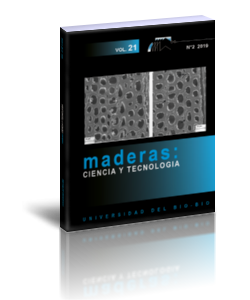Biological resistance of heat-treated wood of Pinus caribaea and Eucalyptus saligna
Keywords:
Brown-rot fungi, decay fungi, soft-rot fungi, thermally treated wood, white-rot fungi, wood preservation, wood heat treatmentAbstract
This study aimed to analyze the resistance of the thermally treated wood of Pinus caribaea and Eucalyptus saligna to the biological attack of wood rotting fungi. The heat treatment processes were carried out in electric oven under nitrogen atmosphere, starting from 100 °C until reaching each one of the final temperatures of the process: 120, 140, 160, and 180 °C. The resistance assays were performed for white rot, brown rot, and soft rot fungi. The increase in decay resistance was observed for heat-treated wood of Pinus caribaea at higher temperatures. On the other hand, Eucalyptus saligna showed increased resistance to rotting fungi at all tested temperatures, except for white and soft rot at 120 °C. In general, the heat treatment process showed good results for its use as a wood preservative method.
Downloads
References
American Society for Testing and Materials. ASTM. 2005. Standard test method for accelerated laboratory test of natural decay resistance of wood ASTM D-2017. Philadelphia, 5p.
Batista, D.; Muñiz, G.I.; Da Silva, J.T.; Paes, J.; Nisgoski, S. 2016. Effect of the Brazilian thermal modification process on the chemical composition of Eucalyptus grandis juvenile wood: Part 1: Cell wall polymers and extractives contents. Maderas-Cienc Tecnol 18(2):273-284.
Brito, J.O. 1992. Estudo das influências da temperatura, taxa de aquecimento e densidade da madeira de Eucalyptus maculata e Eucalyptus citriodora sobre os resíduos sólidos da pirólise. Ph.D. Thesis (Livre Docência) - Escola Superior de Agricultura ‘‘Luiz de Queiroz”, Universidade de São Paulo. Piracicaba. p. 81.
Brito, J.O.; Silva, F.G.; Leão, M.M.; Almeida, G. 2008. Chemical composition changes in Eucalyptus and Pinus woods submitted to heat treatment. Bioresource Technology 99(18): 8545-8548.
Brito, J.O.; Garcia, J.N.; Bortoletto, G. 2006. Densidade básica e retratibilidade da madeira de Eucalyptus grandis submetida a diferentes temperaturas de termorretificação. Cerne 12(2): 182-188.
Doi, S.; Aoyama, M.; Yamauchi, S.; Kurimoto, Y. 2005. Changes of decay and termite durabilities of Japanese larch (Larix leptolepis) wood due to high-temperature kiln drying processes. Journal of Wood Science 1(5): 526-530.
Ferrarini, S.F.; Santos, H.S.; Miranda, L.G.; Azevedo, C.M.N.; Pires, M.J.R.; Maia, S.M. 2012. Classification of waste wood treated with chromated copper arsenate and boron/fluorine preservatives. Química Nova 35(9): 1767-1771.
Garcia, R.A.; Carvalho, A.M.; Latorraca, J.V.F.; Matos, J.L.M.; Santos, W.A.; Silva, R.F.M. 2012. Nondestructive evaluation of heat-treated Eucalyptus grandis Hill ex Maiden wood using stress wave method. Wood Science and Technology 46(1): 41-52.
Instituto de Pesquisas Tecnológicas. IPT. 1980. Ensaio acelerado de laboratório para a determinação da eficiência de preservativos contra fungos da podridão-mole. São Paulo: IPT/DIMAD. 2p.
Metsä-Kortelainen, S.; Anitikainen, T.; Viitaniemi, P. 2005. The water absorption of sapwood and heartwood of Scots pines and Norway spruce heat-treated at 170ºC, 190ºC, 210ºC and 230ºC. Holz als Roh- und Werkstoff 64(3):192-197.
Modes, K.S. 2010. Efeito da retificação térmica nas propriedades físico-mecânicas e biológica das madeiras de Pinus taeda e Eucalyptus grandis. MSc. Thesis. Universidade Federal de Santa Maria, 99p. < https://repositorio.ufsm.br/bitstream/handle/1/8669/MODES%2c%20KARINA%20SOARES.pdf?sequence=1&isAllowed=y >. (Access 04/02/2019)
Palermo, G.P.M.; Latorraca, J.V.F.; Moura, L.F.; Nolasco, A.M.; Carvalho, A.M.; Garcia, R.A. 2015. Surface roughness of heat treated Eucalyptus grandis wood. Maderas-Cienc Tecnol 16(1): 03-12.
Pincelli, A.L.P.S.M.; Brito, J.O.; Corrente, J.E. 2002. Avaliação da termorretificação sobre a colagem na madeira de Eucalyptus saligna e Pinus caribaea var. hondurensis. Scientia Forestalis 61(3): 122-132.
Poletto, M. 2017. Assessment of the thermal behavior of lignins from softwood and hardwood species. Maderas-Cienc Tecnol 19(1): 63-74.
Puls, J.; Poutanen, K.; Körner, HU.; Viikari, L. 1985. Biotechnical utilization of wood carbohydrates after steaming pretreatment. Applied Microbiology and Biotechnology 22(6): 416-423.
Rocha, C.D. 2011. Efeito da vaporização na madeira de Eucalyptus grandis sobre as suas propriedades químicas e resistência natural a fungos e cupins. MSc. Thesis. Universidade Estadual Paulista. Botucatu-SP. 121p. < https://repositorio.unesp.br/bitstream/handle/11449/99760/rocha_cd_me_botfca.pdf?sequence=1&isAllowed=y >. (Access 04/02/2019).
Rousset, P.; Perré, P.; Girard, P. 2004. Modification of mass transfer properties in poplar wood (P. robusta) by thermal treatment at high temperature. Holz als Roh- und Werkstoff 62(2): 113-119.
Vivian, M.A.; Santini, E.J.; Modes, K.S.; Garlet, A.; Morais, W.W.C. 2015. Resistência biológica da madeira tratada de Eucalyptus grandis e Eucalyptus cloeziana a fungos apodrecedores em ensaios de laboratório. Ciência Florestal 25(1): 175-183.
Weiland, J.J.; Guyonnet, R. 2003. Study of chemical modifications and fungi degradation of thermally modified wood using DRIFT spectroscopy. Holz als Roh-Werkstoff 61(2): 216-220.
Wikberg, H.; Maunu, S.L. 2004. Characterization of thermally modified hard and softwoods by 13C CPMAS NMR. Carbohidrate Polymers 58(4): 461-466.
































